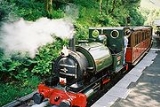
List of Talyllyn Railway rolling stock
Encyclopedia
This is a list of past and present rolling stock
used on the Talyllyn Railway
, a narrow gauge preserved
railway line running for 7.25 miles (11.7 km) from Tywyn
on the Mid-Wales coast to Nant Gwernol
near the village of Abergynolwyn
. The line was opened in 1866 to carry slate
from the quarries at Bryn Eglwys
to Tywyn, and was the first narrow gauge railway in Britain authorised by Act of Parliament to carry passengers using steam haulage. Despite severe under-investment, the line remained open, and in 1951 it became the first railway in the world to be preserved as a heritage railway by volunteers.
When first opened, the railway owned two steam locomotives, Talyllyn
and Dolgoch
, and five carriages, including one brake van. There were no additions to the rolling stock until the line was taken over in 1951. Two ex-Corris Railway
locomotives were then purchased from British Railways, and subsequent additions brought the total up to six steam locomotives, four diesels and 23 carriages.
Simplex diesel No. 5 Alan Meaden and Winson Engineering
and Drayton Designs No. 7 Tattoo class design similar to the Talyllyn's No. 4. Both these are locomotives from the Corris Railway.
coaches were built for the railway after preservation; the smaller four wheeled coaches are generally older.
All the stock is third class only, unless otherwise stated. Where two figures are given for the number of seats, the larger figure is the maximum number of passengers than can be carried in a heavily loaded train.
. It owns several wagons formerly in use on the railway (listed above), as well as rolling stock and other artefacts from other narrow gauge railways around the world. The wagons are still used occasionally on the Talyllyn.
for locomotives on the Talyllyn is bronze deep green, lined in black and yellow, although since the 1980s there has been a policy of varying some of the liveries for a period of time. It is usual to have one steam engine painted in the guise of one of its fictional counterparts from the Skarloey Railway
and wearing a face on the smokebox. This is usually No. 3 or No. 4, as the red livery closely resembles the colour carried by these locomotives on the Corris Railway.
The liveries carried by the steam locomotives in 2011 are as follows:-
The vintage rolling stock and the carriages built for the line after preservation are cherry red, lined with deep bronze green. Additionally, the railway has preserved rolling stock from other railways. These retain their original liveries.
The Corris coach (Talyllyn No. 17) and brake van (Talyllyn No. 6) are brown lined with gold leaf and the two Glyn Valley Tramway
coaches (Talyllyn Nos. 14 and 15) are green lined with white.
Rolling stock
Rolling stock comprises all the vehicles that move on a railway. It usually includes both powered and unpowered vehicles, for example locomotives, railroad cars, coaches and wagons...
used on the Talyllyn Railway
Talyllyn Railway
The Talyllyn Railway is a narrow-gauge preserved railway in Wales running for from Tywyn on the Mid-Wales coast to Nant Gwernol near the village of Abergynolwyn. The line was opened in 1866 to carry slate from the quarries at Bryn Eglwys to Tywyn, and was the first narrow gauge railway in Britain...
, a narrow gauge preserved
Heritage railway
thumb|right|the Historical [[Khyber train safari|Khyber Railway]] goes through the [[Khyber Pass]], [[Pakistan]]A heritage railway , preserved railway , tourist railway , or tourist railroad is a railway that is run as a tourist attraction, in some cases by volunteers, and...
railway line running for 7.25 miles (11.7 km) from Tywyn
Tywyn
Tywyn is a town and seaside resort on the Cardigan Bay coast of southern Gwynedd , in north Wales. The name derives from the Welsh tywyn and the town is sometimes referred to as Tywyn Meirionnydd...
on the Mid-Wales coast to Nant Gwernol
Nant Gwernol railway station
Nant Gwernol railway station is the eastern terminus of the Talyllyn Railway near Abergynolwyn, Gwynedd in mid-Wales. It is 7 miles, 28 chains from ....
near the village of Abergynolwyn
Abergynolwyn
Abergynolwyn is a village in southern Gwynedd, Wales, located at the confluence of the Nant Gwernol and the Afon Dysynni.Historically, the village was part of Merionethshire and its main industry was slate quarrying and the village was founded in the 1860s to house workers at the nearby Bryn...
. The line was opened in 1866 to carry slate
Slate
Slate is a fine-grained, foliated, homogeneous metamorphic rock derived from an original shale-type sedimentary rock composed of clay or volcanic ash through low-grade regional metamorphism. The result is a foliated rock in which the foliation may not correspond to the original sedimentary layering...
from the quarries at Bryn Eglwys
Bryn Eglwys
Bryn Eglwys was a remote slate quarry located near Abergynolwyn in Gwynedd mid-Wales.- History :The quarry was first worked on a small scale in the early 1840s. In 1864 William McConnel leased the quarry, forming the Aberdovey Slate Company Limited. McConnel planned to increase production at Bryn...
to Tywyn, and was the first narrow gauge railway in Britain authorised by Act of Parliament to carry passengers using steam haulage. Despite severe under-investment, the line remained open, and in 1951 it became the first railway in the world to be preserved as a heritage railway by volunteers.
When first opened, the railway owned two steam locomotives, Talyllyn
Talyllyn (locomotive)
Talyllyn is a narrow gauge steam locomotive. It was built by Fletcher, Jennings & Co. in 1864 and is one of the oldest locomotives still in active service...
and Dolgoch
Dolgoch (locomotive)
Dolgoch is a narrow gauge 0-4-0 well tank steam locomotive. It was built by Fletcher, Jennings & Co. in 1866 and is one of the oldest locomotives still in active service. It was delivered to the Talyllyn Railway in 1866 and continues to run on this railway....
, and five carriages, including one brake van. There were no additions to the rolling stock until the line was taken over in 1951. Two ex-Corris Railway
Corris Railway
The Corris Railway is a narrow gauge preserved railway based in Corris on the border between Merionethshire and Montgomeryshire in Mid-Wales....
locomotives were then purchased from British Railways, and subsequent additions brought the total up to six steam locomotives, four diesels and 23 carriages.
Locomotives
The line has six steam locomotives for passenger trains and four diesel locomotives that usually haul only works trains. It is unusual for all steam locomotives to be operable at one time, as there is usually at least one locomotive undergoing overhaul. As of December 2010, all steam locos are available for service unless otherwise stated.Steam locomotives
| Number | Name | Image | Type | Builder | Works number | Date built | Cylinder size | Boiler pressure |
|---|---|---|---|---|---|---|---|---|
| 1 | Talyllyn Talyllyn (locomotive) Talyllyn is a narrow gauge steam locomotive. It was built by Fletcher, Jennings & Co. in 1864 and is one of the oldest locomotives still in active service... |
Fletcher, Jennings & Co. Fletcher, Jennings & Co. Fletcher, Jennings & Co. was an engineering company at Lowca near Whitehaven, Cumbria, England.-Overview:Fletcher and Jennings took over the business of Tulk and Ley in 1857... , Whitehaven |
42 | 1864 | 8⅝ in x 16 in (219 mm x 406 mm) |
160 psi (1,103.2 kPa) | ||
| One of two original locomotives, it was built as an without a cab. By 1866, trailing wheels had been added to improve stability, and it had a cab installed at the same time. It was named after the railway. | ||||||||
| 2 | Dolgoch Dolgoch (locomotive) Dolgoch is a narrow gauge 0-4-0 well tank steam locomotive. It was built by Fletcher, Jennings & Co. in 1866 and is one of the oldest locomotives still in active service. It was delivered to the Talyllyn Railway in 1866 and continues to run on this railway.... |
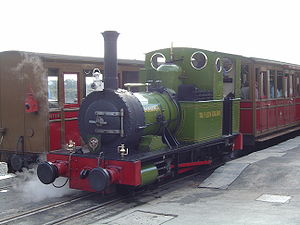 |
Fletcher, Jennings & Co., Whitehaven |
63 | 1866 | 7⅝ in x 16 in (194 mm x 406 mm) |
150 psi (1,034.2 kPa) | |
| The second original locomotive. Like Talyllyn, it was built without a cab, though one was subsequently added. It was named after the intermediate station and local waterfalls, though after the Boer War Second Boer War The Second Boer War was fought from 11 October 1899 until 31 May 1902 between the British Empire and the Afrikaans-speaking Dutch settlers of two independent Boer republics, the South African Republic and the Orange Free State... , it carried the name Pretoria Pretoria Pretoria is a city located in the northern part of Gauteng Province, South Africa. It is one of the country's three capital cities, serving as the executive and de facto national capital; the others are Cape Town, the legislative capital, and Bloemfontein, the judicial capital.Pretoria is... for several years. In 2011 it received a new boiler, and returned to steam in time for the 60th anniversary celebrations of the preservation society on 14 May. |
||||||||
| 3 | Sir Haydn Sir Haydn (locomotive) Sir Haydn is a narrow gauge steam locomotive, built by Hughes' Locomotive & Tramway Engine Works Ltd of the Falcon Works, Loughborough in 1878. It operated on the Corris Railway in Wales, until closure in 1948, and since 1951 has operated on the nearby Talyllyn Railway... |
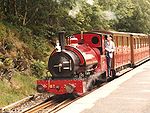 |
Hughes, Falcon Works, Loughborough |
323 | 1878 | 7⅛ in x 12 in (181 mm x 305 mm) |
160 psi (1,103.2 kPa) | |
| An ex-Corris Railway Corris Railway The Corris Railway is a narrow gauge preserved railway based in Corris on the border between Merionethshire and Montgomeryshire in Mid-Wales.... locomotive, purchased in 1951 and subsequently named after Sir Henry Haydn Jones Henry Haydn Jones Sir Henry Haydn Jones was a Welsh Liberal Party politician.- Upbringing :Henry Haydn Jones was born in Ruthin, Wales. He was the son of Joseph David Jones , a schoolmaster in the town and a respected Welsh musician and composer... , owner of the railway prior to preservation. Due for 10 year overhaul mid 2012. |
||||||||
| 4 | Edward Thomas Edward Thomas (locomotive) Edward Thomas is a narrow gauge steam locomotive. Built by Kerr Stuart & Co. Ltd. at the California Works, Stoke-on-Trent in 1921, it was delivered new to the Corris Railway where it ran until 1948. After that railway closed, the locomotive was brought to the Talyllyn Railway in 1951, then... |
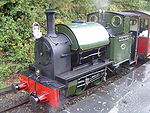 |
Kerr Stuart Kerr Stuart Kerr, Stuart and Company Ltd was a locomotive manufacturer from Stoke-on-Trent, England.-History:It was founded in 1881 by James Kerr as James Kerr & Company, and became Kerr, Stuart & Company from 1883 when John Stuart was taken on as a partner... , Stoke on Trent |
4047 | 1921 | 7⅛ in x 12 in (181 mm x 305 mm) |
160 psi (1,103.2 kPa) | |
| The second ex-Corris Railway locomotive, also purchased in 1951 and subsequently named after the general manager of the line prior to preservation. It was fitted with a Giesl ejector Giesl ejector A Giesl ejector is a suction draught system for steam locomotives that works on the same principle as a feedwater pump.This ejector was invented in 1951 by the Austrian engineer, Dr. Adolph Giesl-Gieslingen. The Giesl ejector ensures improved suction draught and a correspondingly better use of... between 1958 and 1969. |
||||||||
| 6 | Douglas Douglas (locomotive) Douglas is a narrow gauge steam locomotive. It was built by Andrew Barclay & Co. Ltd. in 1918. It was originally used by the Air Service Constructional Corps then was bought in 1949 by Abelson & Co. Ltd... |
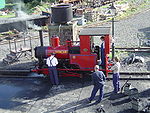 |
Andrew Barclay, Kilmarnock | 1431 | 1918 | 6⅞ in x 10¾ in (175 mm x 273 mm) |
160 psi (1,103.2 kPa) | |
| A "Modified E Class", built for the depot railway serving RAF Calshot RAF Calshot RAF Calshot was initially a seaplane and flying boat station, and latterly an RAF marine craft maintenance and training unit. It was located at the end of Calshot Spit in Southampton Water, Hampshire, England, at... . It was donated to the Talyllyn in 1953, regauged from gauge and named after Douglas Abelson, who donated the locomotive. In 2007 it was stripped down for boiler overhaul; the work has been sidelined by the work on Loco No. 2 Dolgoch. |
||||||||
| 7 | Tom Rolt Tom Rolt (locomotive) Tom Rolt is a narrow gauge steam locomotive constructed by the Talyllyn Railway using parts from an Andrew Barclay locomotive built in 1949 for Bord na Móna.-Bord na Móna:... |
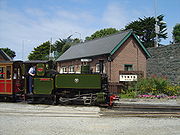 |
Talyllyn Railway | none given | 1991 | 8½ in x 12 in (216 mm x 305 mm) |
180 psi (1,241.1 kPa) | |
| This locomotive was built by the Talyllyn Railway using components from a Bord na Móna Bord na Móna Bord na Móna , abbreviated BNM, is a semi-state company in Ireland, created in 1946 by the Turf Development Act 1946. The company is responsible for the mechanised harvesting of peat, primarily in the Midlands of Ireland... (Irish Peat Board) Andrew Barclay locomotive. It was originally intended to give it the jocular name Irish Pete. However, prior to completion, it was decided to name it in honour of L.T.C. Rolt, one of the founders of the Talyllyn Railway Preservation Society. |
||||||||
Diesel locomotives
| Number | Name | Image | Type | Builder | Date built | Power (hp Horsepower Horsepower is the name of several units of measurement of power. The most common definitions equal between 735.5 and 750 watts.Horsepower was originally defined to compare the output of steam engines with the power of draft horses in continuous operation. The unit was widely adopted to measure the... ) |
Wheel diameter |
|---|---|---|---|---|---|---|---|
| 5 | Midlander | 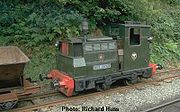 |
4wDM | Ruston & Hornsby | 1941 | 48 | 1 inch |
| This locomotive was purchased in 1957 from Jee's quarries at Hartshill Hartshill Hartshill is a village in the borough of North Warwickshire, England.Hartshill is three miles from Nuneaton town centre but is still regarded as a suburb of the town despite being in the North Warwickshire borough.... , and contains parts that were cannibalised off an identical locomotive. It was named after the Midlands English Midlands The Midlands, or the English Midlands, is the traditional name for the area comprising central England that broadly corresponds to the early medieval Kingdom of Mercia. It borders Southern England, Northern England, East Anglia and Wales. Its largest city is Birmingham, and it was an important... area group of the preservation society that donated the locomotive. |
|||||||
| 8 | Merseysider | 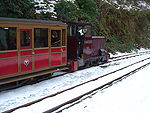 |
4wDH | Ruston & Hornsby | 1964 | 50 | 1 inch |
| This was originally built using parts from three gauge locomotives from Park Gate steelworks in Rotherham Rotherham Rotherham is a town in South Yorkshire, England. It lies on the River Don, at its confluence with the River Rother, between Sheffield and Doncaster. Rotherham, at from Sheffield City Centre, is surrounded by several smaller settlements, which together form the wider Metropolitan Borough of... , acquired in 1969. The superstructure was replaced c. 2000. It has a Dowty hydrostatic transmission. The name was chosen by the donor of the locomotive. |
|||||||
| 9 | Alf | 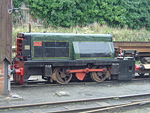 |
0-4-0DM | Hunslet Engine Co. | 1950 | 75 | 2 ft (0.6096 m) |
| This is an ex-National Coal Board National Coal Board The National Coal Board was the statutory corporation created to run the nationalised coal mining industry in the United Kingdom. Set up under the Coal Industry Nationalisation Act 1946, it took over the mines on "vesting day", 1 January 1947... locomotive, from Huncoat Huncoat Huncoat is a small village in Lancashire, England; situated in the North West. It is located to the east of Accrington.Huncoat railway station is on the East Lancashire Line.-Origins:... colliery in Lancashire Lancashire Lancashire is a non-metropolitan county of historic origin in the North West of England. It takes its name from the city of Lancaster, and is sometimes known as the County of Lancaster. Although Lancaster is still considered to be the county town, Lancashire County Council is based in Preston... . It was named after Alf Robens Alfred Robens, Baron Robens of Woldingham Alfred Robens, Baron Robens of Woldingham CBE PC was an English trade unionist, Labour politician and industrialist... , chairman of the National Coal Board. |
|||||||
| 10 | Bryn Eglwys | 4wDH | Motor Rail Motor Rail Motor Rail was a British locomotive-building company, based in Bedford. Formed in 1911 as The Motor Rail & Tramcar Co Ltd, they built petrol and diesel engined locomotives, mainly narrow gauge. During World War I over 900 locos were supplied for use on temporary military supply railways... |
1985 | 110 | 1 inch | |
| This was originally a gauge National Coal Board locomotive from Hem Heath colliery near Stoke-on-Trent Stoke-on-Trent Stoke-on-Trent , also called The Potteries is a city in Staffordshire, England, which forms a linear conurbation almost 12 miles long, with an area of . Together with the Borough of Newcastle-under-Lyme Stoke forms The Potteries Urban Area... . It arrived on the Talyllyn September 1997, and was re-painted into standard Talyllyn livery during summer 2005. The locomotive is named after the Bryn Eglwys Bryn Eglwys Bryn Eglwys was a remote slate quarry located near Abergynolwyn in Gwynedd mid-Wales.- History :The quarry was first worked on a small scale in the early 1840s. In 1864 William McConnel leased the quarry, forming the Aberdovey Slate Company Limited. McConnel planned to increase production at Bryn... slate quarries. |
|||||||
| Unnamed | 4wDH | Baguley Ernest E. Baguley -Employment:Baguley served an apprenticeship with R & W Hawthorn Leslie, initially at their Tyneside shipyard and later at their Forth Bank, Newcastle, locomotive works. In 1890 he moved to Stafford and became Chief Draughtsman for W G Bagnall Ltd... |
? | ? | ? | ||
| Three Baguley diesels, numbered T 0006 00 NZ 32 (BD 3764), BD 3779 and T 0009 00 NZ 35 (BD 3781), were purchased from Trecwn RNAD Royal Naval Armaments Depot A Royal Naval Armament Depot was a group of armament depots dedicated to supplying the needs of the Royal Navy as well as the Royal Air Force, British Army and foreign/commonwealth governments; they were sister depots of Royal Naval Cordite Factories, Royal Naval Torpedo and Royal Naval Mine Depots... in South Wales in 2008. These are owned by a consortium of volunteers, and not by the railway itself. Two locomotives will be converted to gauge in due course, with the third being used for spares. |
|||||||
Self-propelled engineering plant
| Name | Image | Type | Builder | Date built | Notes |
|---|---|---|---|---|---|
| "Toby"Names in inverted commas refer to unofficial nick-names, not formally applied. | Permanent Way Trolley | John Bate | 1955 | Small trolley used by engineers for transportation to worksites. Built from a second hand Austin 7 Austin 7 The Austin 7 was a car produced from 1922 through to 1939 in the United Kingdom by the Austin Motor Company. Nicknamed the "Baby Austin", it was one of the most popular cars ever produced for the British market, and sold well abroad... engine and gearbox, mounted on a custom-made chassis. |
|
| - | 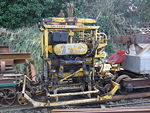 |
Ballast tamper Ballast tamper A ballast tamper or tamping machine is a machine used to pack the track ballast under railway tracks to make the tracks more durable. Prior to the introduction of mechanical tampers, this task was done by manual labour with the help of beaters... |
Matisa | 1990 | Rail mounted track tamper. Parts of two ex-MOD Ministry of Defence (United Kingdom) The Ministry of Defence is the United Kingdom government department responsible for implementation of government defence policy and is the headquarters of the British Armed Forces.... standard gauge Standard gauge The standard gauge is a widely-used track gauge . Approximately 60% of the world's existing railway lines are built to this gauge... tampers were acquired in 1989 and one complete machine was assembled and commissioned on 26 June 1990. |
| - | 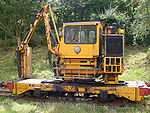 |
Flail Mower | Talyllyn Railway | 1998 | Rail mounted self propelled vehicle used to clear lineside vegetation. Designed by John Bate (Chief Engineer 1963-1994) and built from chassis components from two Ruston & Hornsby Ruston (engine builder) Ruston & Hornsby, later known as Ruston, was an industrial equipment manufacturer in Lincoln, England, the company's history going back to 1840. The company is best known as a manufacturer of narrow and standard gauge diesel locomotives and also of steam shovels. Other products included cars, steam... locomotives, the framing and motor components of a Smalley excavator, the flail mechanism and cab from a McConnel flail mower Flail mower A flail mower is a type of PTO driven implement that can attach to the three-point hitches found on the rear of most tractors. This type of mower is best used to provide a rough cut to taller grass where contact with loose debris may be possible such as roadsides.The flail mower gets its name from... and a new Perkins diesel power unit. |
Former locomotives
| Number | Name | Type | Builder | Date built | Power (hp Horsepower Horsepower is the name of several units of measurement of power. The most common definitions equal between 735.5 and 750 watts.Horsepower was originally defined to compare the output of steam engines with the power of draft horses in continuous operation. The unit was widely adopted to measure the... ) |
Year with- drawn |
|---|---|---|---|---|---|---|
| 5 | "The Lawnmower" | 4wPM | David Curwen | 1952 | 20 | 1953 |
| Built by member David Curwen using the engine from a Model T Ford Ford Model T The Ford Model T is an automobile that was produced by Henry Ford's Ford Motor Company from September 1908 to May 1927... , the transmission from L.T.C Rolt's narrowboat Narrowboat A narrowboat or narrow boat is a boat of a distinctive design, made to fit the narrow canals of Great Britain.In the context of British Inland Waterways, "narrow boat" refers to the original working boats built in the 18th, 19th, and 20th centuries for carrying goods on the narrow canals... and the wheels from a Talyllyn Railway slate wagon. Worked the Fridays-only winter passenger service. Out of use with a failed gearbox by 1953, dismantled in 1954. Converted to flat wagon No. 19 (see below). |
||||||
| 7 | "Charley's Ant" | 4-2-0 | Talyllyn Railway | 1954 | c.1958 | |
| A Mercury tractor Tractor A tractor is a vehicle specifically designed to deliver a high tractive effort at slow speeds, for the purposes of hauling a trailer or machinery used in agriculture or construction... that had been adapted to push standard gauge rolling stock by the addition of a buffer beam. Further adapted in 1954 for use on the Talyllyn, and later converted to run on paraffin instead of petrol. It was little used after 1958 and later scrapped. It was nicknamed after Charles Uren, the railway's chief engineer. |
||||||
Visiting locomotives
Because of the unusual gauge, there have only been two visiting locomotives to date. These are Motor RailMotor Rail
Motor Rail was a British locomotive-building company, based in Bedford. Formed in 1911 as The Motor Rail & Tramcar Co Ltd, they built petrol and diesel engined locomotives, mainly narrow gauge. During World War I over 900 locos were supplied for use on temporary military supply railways...
Simplex diesel No. 5 Alan Meaden and Winson Engineering
Winson Engineering
Winson Engineering was a British manufacturer of narrow gauge and miniature railway steam locomotives and rolling stock during the 1990s. It built several new locomotives for heritage railways as well as undertaking major rebuilds of existing locomotives....
and Drayton Designs No. 7 Tattoo class design similar to the Talyllyn's No. 4. Both these are locomotives from the Corris Railway.
| Number | Name | Image | Type | Builder | Date built | Notes |
|---|---|---|---|---|---|---|
| 5 | Alan Meaden | 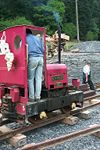 |
4w DM | Motor Rail Motor Rail Motor Rail was a British locomotive-building company, based in Bedford. Formed in 1911 as The Motor Rail & Tramcar Co Ltd, they built petrol and diesel engined locomotives, mainly narrow gauge. During World War I over 900 locos were supplied for use on temporary military supply railways... Simplex |
1965 | A former gauge diesel from Staveley Lime Products, Hindlow, Derbyshire, named in honour of the Corris Society's founder. It visited the Talyllyn in 1983 and 1990. |
| 7 | 0-4-2 0-4-2 Under the Whyte notation for the classification of steam locomotives, 0-4-2 represents the wheel arrangement with no leading wheels, four powered and coupled driving wheels on two axles, and two trailing wheels on one axle... ST ST ST or St may refer to:In geography:* São Tomé and Príncipe, ISO 3166-1 country codeIn technology:* .st, Internet country code top-level domain for São Tomé and Príncipe* ST connector, a type of optical fiber connector... |
Winson Engineering Winson Engineering Winson Engineering was a British manufacturer of narrow gauge and miniature railway steam locomotives and rolling stock during the 1990s. It built several new locomotives for heritage railways as well as undertaking major rebuilds of existing locomotives.... and Drayton Designs |
2005 | Built for the Corris Railway, based on the Kerr Stuart "Tattoo" class design of Corris No. 4. It visited the Talyllyn in 2011. |
Carriages
The Talyllyn railway has a total of 23 carriages. The first five are the original carriages built for the railway, though they were not provided with numbers until preservation in 1951. After that time, the remaining carriages were built by the railway or acquired from elsewhere. With the exception of ex-Corris carriage No. 17, all the bogieBogie
A bogie is a wheeled wagon or trolley. In mechanics terms, a bogie is a chassis or framework carrying wheels, attached to a vehicle. It can be fixed in place, as on a cargo truck, mounted on a swivel, as on a railway carriage/car or locomotive, or sprung as in the suspension of a caterpillar...
coaches were built for the railway after preservation; the smaller four wheeled coaches are generally older.
All the stock is third class only, unless otherwise stated. Where two figures are given for the number of seats, the larger figure is the maximum number of passengers than can be carried in a heavily loaded train.
Four wheeled carriages
| Number | Image | Builder | Date built | Seats | Notes |
|---|---|---|---|---|---|
| 1 | 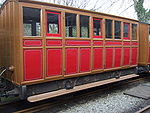 |
Brown, Marshalls Brown, Marshalls and Co. Ltd. Brown, Marshalls and Co. Ltd. were a company that built railway carriages, based in Saltley, Birmingham, in the UK. They were formed in 1840. In 1866 they built the original coaches for the Talyllyn Railway, which are still in use, and in 1873 built two bogie coaches for the Ffestiniog Railway.... |
1867 | 18 | This was originally a first class carriage; it is now third class. |
| 2 | 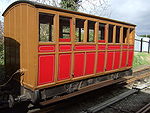 |
Brown, Marshalls Brown, Marshalls and Co. Ltd. Brown, Marshalls and Co. Ltd. were a company that built railway carriages, based in Saltley, Birmingham, in the UK. They were formed in 1840. In 1866 they built the original coaches for the Talyllyn Railway, which are still in use, and in 1873 built two bogie coaches for the Ffestiniog Railway.... |
1867 | 18 | |
| 3 | 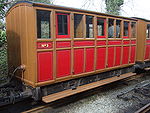 |
Brown, Marshalls Brown, Marshalls and Co. Ltd. Brown, Marshalls and Co. Ltd. were a company that built railway carriages, based in Saltley, Birmingham, in the UK. They were formed in 1840. In 1866 they built the original coaches for the Talyllyn Railway, which are still in use, and in 1873 built two bogie coaches for the Ffestiniog Railway.... |
1866 | 18 | This was the first carriage to be delivered, and is 1 feet (30.5 cm) shorter than Nos. 1 and 2. Originally third class, it was later changed to composite (first and third class), but is now third class again. |
| 4 | 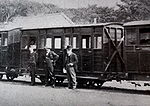 |
Lancaster Wagon | 1867 | 18 | In the 1950s, this carriage was known as "Limping Lulu" to railway staff due to the poor state of the frames, which were replaced in 1958. |
| 5 |  |
Brown, Marshalls Brown, Marshalls and Co. Ltd. Brown, Marshalls and Co. Ltd. were a company that built railway carriages, based in Saltley, Birmingham, in the UK. They were formed in 1840. In 1866 they built the original coaches for the Talyllyn Railway, which are still in use, and in 1873 built two bogie coaches for the Ffestiniog Railway.... |
1866 | none | This was the original guard's van Brake van Brake van and guard's van are terms used mainly in the UK, Australia and India for a railway vehicle equipped with a hand brake which can be applied by the guard... . |
| 6 | Falcon Works | 1885 | none | This guard's van was originally from the Corris Railway Corris Railway The Corris Railway is a narrow gauge preserved railway based in Corris on the border between Merionethshire and Montgomeryshire in Mid-Wales.... . |
|
| 7 | Believed de Winton De Winton De Winton & Co were engineers in Caernarfon, Wales. They built vertical boilered narrow gauge locomotives for use in Welsh slate mines and other industrial settings. At least six De Winton locomotives have been preserved... . Rebuilt by the Talyllyn Railway. |
c. 1900. | 13 | This was ex-Penrhyn Quarry Railway Penrhyn Quarry Railway The Penrhyn Quarry Railway first opened in 1798 as the Llandegai Tramway; it became the Penrhyn Railway in 1801 although on a different route. Constructed to transport slate from Lord Penrhyn's slate quarries at Bethesda to Port Penrhyn at Bangor, Wales. The railway was around six miles long... open carriage 'H'. It operated on the Talyllyn until 1961, and was later used as a tea van at , then as a generator wagon. During 1985 and 1986 it was completely rebuilt as a wheelchair saloon with guards compartment. |
|
| 8 | 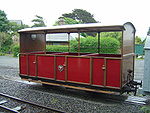 |
Penrhyn Quarry Railway Penrhyn Quarry Railway The Penrhyn Quarry Railway first opened in 1798 as the Llandegai Tramway; it became the Penrhyn Railway in 1801 although on a different route. Constructed to transport slate from Lord Penrhyn's slate quarries at Bethesda to Port Penrhyn at Bangor, Wales. The railway was around six miles long... . Rebuilt by the Talyllyn railway. |
c. 1900. | 24 | This is an open-sided carriage that was originally Penrhyn Quarry Railway open carriage 'P'. It operated on the Talyllyn until 1964, when it was rebuilt from scratch in its current state. |
| 11 | 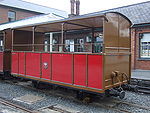 |
Penrhyn Quarry Railway Penrhyn Quarry Railway The Penrhyn Quarry Railway first opened in 1798 as the Llandegai Tramway; it became the Penrhyn Railway in 1801 although on a different route. Constructed to transport slate from Lord Penrhyn's slate quarries at Bethesda to Port Penrhyn at Bangor, Wales. The railway was around six miles long... . Converted by the Talyllyn Railway |
Unknown. Converted in 1955. | 24 | Open sided |
| 12 | Talyllyn Railway | 1956 | 24 | Open sided. | |
| 13 | 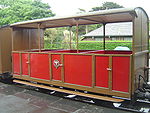 |
Talyllyn Railway | 1957 | 24 | Open sided. |
| 14 | 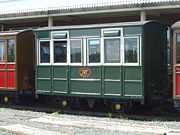 |
Midland R.C.&W. | 1892 | 12 | First class. Ex-Glyn Valley Tramway Glyn Valley Tramway The Glyn Valley Tramway was a narrow gauge railway that connected Chirk with Glyn Ceiriog in Denbighshire , Wales. The gauge of the line was... . |
| 15 | Midland R.C.&W. | 1892 | 12 | First class. Ex-Glyn Valley Tramway Glyn Valley Tramway The Glyn Valley Tramway was a narrow gauge railway that connected Chirk with Glyn Ceiriog in Denbighshire , Wales. The gauge of the line was... . |
Bogie carriages
| Number | Image | Builder | Date built | Seats | Notes |
|---|---|---|---|---|---|
| 9 | 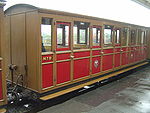 |
W.G. Allen & Tisdales | 1954 | 30/40 | |
| 10 | 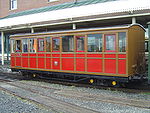 |
W.G. Allen & Tisdales | 1954 | 18/24 | Contains guards compartment. |
| 16 | 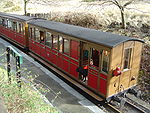 |
Kerr Stuart & TR | 1961 | 18/24 | Contains guards compartment. |
| 17 |  |
Metropolitan C.&W. Metro Cammell The Metropolitan Cammell Carriage and Wagon Company was a Birmingham, England based manufacturer of railway carriages and wagons, based in Saltley and subsequently Washwood Heath.... |
1898 | 22 | Ex-Corris Railway. |
| 18 | 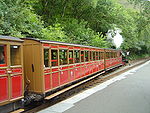 |
Talyllyn Railway | 1965 | 36/48 | |
| 19 | 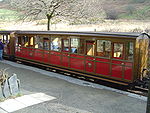 |
Talyllyn Railway & Tisdales | 1969 | 12 1st class, 24/32 3rd class | Composite carriage |
| 20 |  |
Talyllyn Railway & Tisdales | 1970 | 32/41 | Wheelchair saloon. |
| 21 | 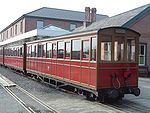 |
Talyllyn Railway & Tisdales | 1971 | 32/41 | Wheelchair saloon. |
| 22 | 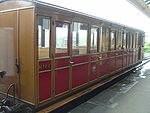 |
Talyllyn Railway & Tisdales | 1972 | 24/32 | Contains guards compartment. |
| 23 | 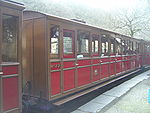 |
Talyllyn Railway & Tisdales | 1975 | 36/48 |
Goods wagons
The Talyllyn Railway was primarily constructed for conveying slate. Prior to the beginning of the 20th century, the railway owned over 115 wagons, mainly slate wagons, but also a number of other general and special purpose goods wagons. Some of these survived into the preservation era, and since then a large number of additional wagons have been purchased and built. The following table lists the main types of wagon currently in use:| Number | Image | Body type | Origin | Notes |
|---|---|---|---|---|
| 1 | 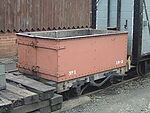 |
Open end door | Corris Railway Corris Railway The Corris Railway is a narrow gauge preserved railway based in Corris on the border between Merionethshire and Montgomeryshire in Mid-Wales.... |
A 2 long ton coal wagon, acquired in 1951 from the Corris Railway. |
| 4 | Open side door | Corris Railway | A 1 long ton coal wagon, acquired in 1951 from the Corris Railway. | |
| 5, 8, 11, 13, 15, 17 | 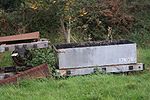 |
Open end door | Talyllyn Railway | |
| 6, 7, 9 | 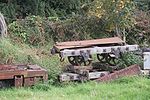 |
Underframe only | Talyllyn Railway | |
| 16 | Open side door | Corris Railway | ||
| 19 | Flat wagon | This was converted from the original locomotive No. 5. | ||
| 20, 21, 22, 23, 24 | 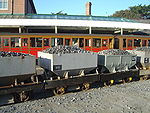 |
Ballast hopper | Winchburgh Winchburgh Winchburgh is a village situated within the geographical county of West Lothian, Scotland. It is located approximately west of the city-centre of Edinburgh, east of Linlithgow and northeast of Broxburn.-Public transport:... Shale Oilworks |
Four of the five hoppers were acquired from Winchburgh in 1961; the fifth was built by the Talyllyn in 1983. |
| 28 | 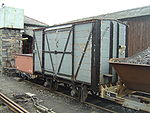 |
Covered van | Ministry of Defence Ministry of Defence (United Kingdom) The Ministry of Defence is the United Kingdom government department responsible for implementation of government defence policy and is the headquarters of the British Armed Forces.... |
Acquired from Trecwn Royal Naval Armaments Depot Royal Naval Armaments Depot A Royal Naval Armament Depot was a group of armament depots dedicated to supplying the needs of the Royal Navy as well as the Royal Air Force, British Army and foreign/commonwealth governments; they were sister depots of Royal Naval Cordite Factories, Royal Naval Torpedo and Royal Naval Mine Depots... in 2007. |
| 29 | 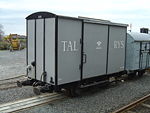 |
Tool van | ||
| 30, 31, 33 | Bolster wagon | Ffestiniog Railway Ffestiniog Railway The Ffestiniog Railway is a narrow gauge heritage railway, located in Gwynedd, Wales. It is a major tourist attraction located mainly within the Snowdonia National Park.... |
Open frame wagons used in pairs to carry timber. | |
| 32, 34, 35 | Flat wagon | Ffestiniog Railway | 3 long ton wagon, acquired in 1956, regauged from gauge. | |
| 36 | Flat wagon with crane | Bowaters Railway Bowaters Paper Railway The Bowaters Paper Railway was a gauge narrow gauge industrial railway. It had the distinction of being the last steam-operated industrial narrow gauge railway in Britain when it closed in 1969.-History:... |
Acquired in 1971 and known as the Boflat. This was fitted with a crane in January 2009. | |
| 37 | 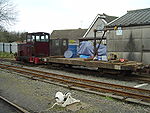 |
Flat wagon with crane | Bowaters Railway | |
| 40, 41, 42, 43, 50, 52, 53, 54, 55 | 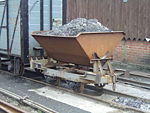 |
Tipper wagon | Cefn Coch quarry | A set of gauge wagons obtained in 1975. |
| 60, 61, 62 | 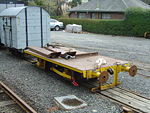 |
Flat wagon | Ministry of Defence | |
| 70 |  |
Bogie brake van | Ministry of Defence | |
| 71, 72 | Bogie flat wagon | Ministry of Defence | ||
| 101, 136, 164 | 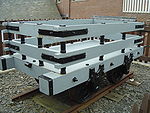 |
Slate wagons | Talyllyn Railway | Two 2-bar and one 3-bar wooden slate wagons, owned by the Narrow Gauge Railway Museum Narrow Gauge Railway Museum The Narrow Gauge Railway Museum is a purpose-built museum dedicated to narrow gauge railways situated at the station of the Talyllyn Railway in Tywyn, Gwynedd, Wales.... . |
| 117 | 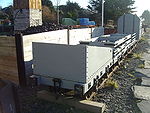 |
Incline open | Talyllyn Railway | Original general purpose wagon, built with sheet iron sides and designed to prevent spillages while hauled on the Abergynolwyn village incline, owned by the Narrow Gauge Railway Museum. |
| 146 | 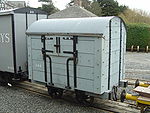 |
Covered van | Talyllyn Railway | Original van, owned by the Narrow Gauge Railway Museum. |
| Unnumbered | Mail Waggon | Corris Railway | Owned by the Narrow Gauge Railway Museum. |
Narrow Gauge Railway Museum rolling stock
The Narrow Gauge Railway Museum is a purpose-built museum dedicated to narrow gauge railways situated on the Tywyn Wharf stationTywyn Wharf railway station
Tywyn Wharf railway station is the western terminus and principal station of the Talyllyn Railway in Tywyn, Gwynedd in mid-Wales.-History:Originally called King's station after a local landowner, it was not a passenger station at first, but a place for transhipment of slates from the narrow gauge...
. It owns several wagons formerly in use on the railway (listed above), as well as rolling stock and other artefacts from other narrow gauge railways around the world. The wagons are still used occasionally on the Talyllyn.
Liveries
The standard liveryLivery
A livery is a uniform, insignia or symbol adorning, in a non-military context, a person, an object or a vehicle that denotes a relationship between the wearer of the livery and an individual or corporate body. Often, elements of the heraldry relating to the individual or corporate body feature in...
for locomotives on the Talyllyn is bronze deep green, lined in black and yellow, although since the 1980s there has been a policy of varying some of the liveries for a period of time. It is usual to have one steam engine painted in the guise of one of its fictional counterparts from the Skarloey Railway
Skarloey Railway
On the fictional Island of Sodor in The Railway Series by Rev. W. Awdry, the Skarloey Railway is a narrow gauge railway which runs from the main line at Crovan's Gate to the passenger terminus at Skarloey. Beyond Skarloey the line continues to a slate quarry.In the stories, the railway is run by...
and wearing a face on the smokebox. This is usually No. 3 or No. 4, as the red livery closely resembles the colour carried by these locomotives on the Corris Railway.
The liveries carried by the steam locomotives in 2011 are as follows:-
- No. 1: Black with red and white lining.
- No. 2: Lined crimson livery.
- No. 3: In Corris Red.
- No. 4: In standard Talyllyn green.
- No. 6: Currently out of service awaiting total overhaul, having previously carried a red livery bearing the name "Duncan" from the fictional "Skarloey Railway".
- No. 7: In standard Talyllyn green.
The vintage rolling stock and the carriages built for the line after preservation are cherry red, lined with deep bronze green. Additionally, the railway has preserved rolling stock from other railways. These retain their original liveries.
The Corris coach (Talyllyn No. 17) and brake van (Talyllyn No. 6) are brown lined with gold leaf and the two Glyn Valley Tramway
Glyn Valley Tramway
The Glyn Valley Tramway was a narrow gauge railway that connected Chirk with Glyn Ceiriog in Denbighshire , Wales. The gauge of the line was...
coaches (Talyllyn Nos. 14 and 15) are green lined with white.

